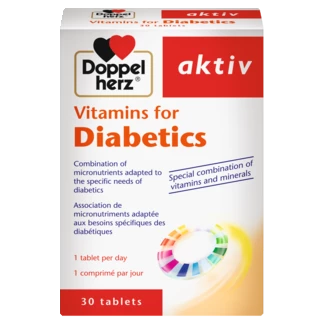Diabetics

Products for diabetics



Diabetes mellitus (diabetes)
This disease is commonly referred to as diabetes. There are several types of diabetes, among which type 1 diabetes and type 2 diabetes are the most prevalent and the best known.
Most common forms: Type 1 diabetes and type 2 diabetes
Type 1 diabetes occurs mostly in young people under the age of 20. Type 1 diabetes is an autoimmune disease, in which the immune system triggers an inflammation of insulin-producing cells of the pancreas, the so-called beta-cells, leading to their destruction and to the inability of the organism to synthesize its own insulin. This is why type-1 diabetics are insulin-dependent and need to regularly take insulin through injection. The interaction between genetic predispositions and other factors is mostly at the origin of the development of type 1 diabetes. This form of diabetes concerns 10% of the diabetics.
Type 2 diabetes usually begins in old age and is characterized by a progressive increase in resistance towards insulin: the body is still producing insulin, but tissues like the muscles and organs like the liver are not able to respond to insulin anymore. This in turn causes an accumulation of glucose in the systemic circulation, which is well-known as hyperglycemia. At later stages, disruption of insulin synthesis may also occur in type 2 diabetics, rendering them de facto insulin-dependent. The main risk factors involved in the development of type II diabetes are obesity and sedentary lifestyle, although genetic factors may also play a role. About 90% of diabetics suffer from this disease. Type 2 diabetes is the most prevalent metabolic disease worldwide and is already a leading cause of death in several countries.
Symptoms of diabetes
Classic symptoms of diabetes are polydipsia (excessive thirst), polyuria (excessive voiding), fatigue, exhaustion, reduced performance, weight loss, visual disturbances, hypoglycemia with a feeling of hunger, cold sweats and tachycardia (fast heartbeat), muscle cramps, nausea and vomiting. Acute complications are hypoglycemic shock, diabetic ketoacidosis and hyperglycemic coma.
In type 1 diabetes, the classic symptoms are usually present, and it almost always begins with diabetic ketoacidosis.
Type 2 diabetes, on the other hand, begins gradually and the classic symptoms are often absent. Complications of diabetes are mainly caused by vascular changes (micro- and macroangiopathy), which severity depends on how long diabetes went undetected, on the quality of metabolic control and on comorbidities. Type 2 diabetes is often diagnosed several years after onset, which explains why its burden so high. The most prevalent complications are: diabetic retinopathy that may develop to blindness, nephropathy up to renal insufficiency, neuropathy, diabetic foot syndrome and cardiovascular complications.
Diagnosis and therapy of diabetes
The diagnostic tools are the same for both type 1 and type 2 diabetes. However, since symptoms of type 1 diabetes are often clear and appear suddenly, this leads to a precocious check of blood sugar levels. Type 2 diabetes on the other hand may be detected following screening guidelines that require testing a particular group of people with higher risk of developing diabetes. These include people above 35 with a BMI higher than normal, with hypercholesterolemia, with a sedentary lifestyle or with a family member with diabetes.
Titration of glucose in blood and urine at random and in fasting state, determination of glycated hemoglobin (HbAl that gives a picture of the average blood glucose levels from the past 2 to 3 months), titration of blood insulin and urine ketone bodies as well as oral glucose load test are the most commonly used diagnostic tools.
Therapy includes general measures such as patient education, diet, reduction of risk factors, oral antidiabetics (sulfonylureas, biguanides, glucosidase inhibitors, guar) and parenteral insulin, especially in the case of type 1 diabetes and complicated type 2 courses.
In order to prevent secondary conditions, diabetics should aim at keeping a metabolic state as stable as possible.